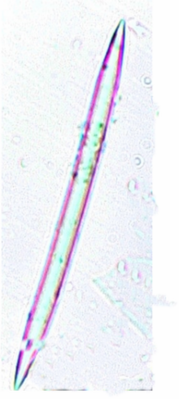Synedra
| Synedra | ||||||||||||
|---|---|---|---|---|---|---|---|---|---|---|---|---|

Synedra sp. |
||||||||||||
| Systematics | ||||||||||||
|
||||||||||||
| Scientific name | ||||||||||||
| Synedra | ||||||||||||
| Ehrenberg |
Synedra (Greek synedros 'sitting together') is a genus of diatoms (Bacillariophyta) with around 100 species that occur in freshwater and seawater . The species arevery similar to Fragilaria , the delimitation of the two genera is unclear.
features
The representatives are elongated, needle-shaped and immobile unicellular algae. The cell is surrounded by the two-bar diatom shell that is characteristic of diatoms. In side view it appears narrowly rectangular, in the shell view it appears needle-shaped or narrowly boat-shaped. The cells are individual, but can also be united to form groups by a jelly. The cells are not curved or bent. The cell nucleus sits centrally. There are usually two elongated plastids that are golden brown due to fucoxanthin and are located on the sides. The two shells have no raphe . The size is 10 to 500 micrometers.
Asexual reproduction occurs through the typical dichotomy of diatoms. Sexual reproduction occurs through anisogamy, with two gametes being formed per cell. After the cells fuse, an auxospore is formed and the cells expand.
The species differ in their cell shape, cell size and colony formation.
Note on nomenclature
Synedra was originally described by Ehrenberg. Many species that were originally assigned to the genus Synedra have since been moved to other genus, especially Fragilaria and Ulnaria. Some of the current names are listed in the Algaebase.
Occurrence
Synedra comes in stagnant and slowly flowing waters and lives stuck or planktisch .
supporting documents
- ↑ Ehrenberg, CG 1832 [ref. 000282]. About the development and lifespan of the infusion animals; along with further contributions to a comparison of their organic systems. Treatises of the Royal Academy of Sciences in Berlin 1831: 1-154, 4 pls.
- ↑ http://www.algaebase.org/search/species/
- Karl-Heinz Linne von Berg, Michael Melkonian u. a .: The Kosmos algae guide. The most important freshwater algae under the microscope. Kosmos, Stuttgart 2004, ISBN 3-440-09719-6 , p. 234.